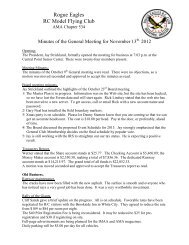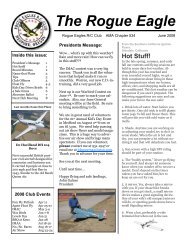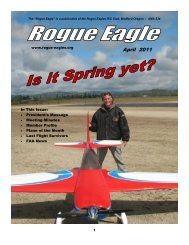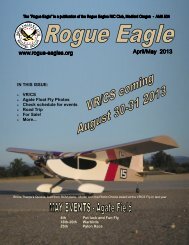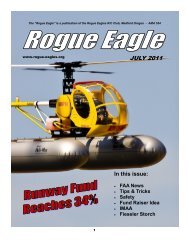April 2012 - The Rogue Eagles R/C Airplane Club
April 2012 - The Rogue Eagles R/C Airplane Club
April 2012 - The Rogue Eagles R/C Airplane Club
Create successful ePaper yourself
Turn your PDF publications into a flip-book with our unique Google optimized e-Paper software.
<strong>The</strong> “<strong>Rogue</strong> Eagle” is a publication of the <strong>Rogue</strong> <strong>Eagles</strong> R/C <strong>Club</strong>, Medford Oregon<br />
www.rogue-eagles.org <strong>April</strong> <strong>2012</strong><br />
IN THIS ISSUE<br />
Richard Pekarek holding the seaplane he<br />
personally designed and built...Beautiful.<br />
All Thumbs—Pres. Message<br />
Electric Presentation Part 2<br />
Float Fly Work Party<br />
Handibond Sale<br />
War Bird Fly In<br />
Sam Arrigo Memorial Fly<br />
Landings<br />
Volunteer Work Party for Float Fly<br />
See Inside for details<br />
1
ALL THUMBS<br />
FROM THE PREZ’S CHAIR<br />
My name is Jay Strickland and I approve this message<br />
How important is communication?<br />
Remember the movie City Slickers<br />
where Curly (Jack Palance) held up his<br />
single forefinger and said “<strong>The</strong>re’s just<br />
one thing”. Communication might very<br />
well be that one thing. On the battlefield<br />
we have a saying, comms is king!<br />
Before we do anything else we set up<br />
and establish communication. Without<br />
the ability to pass information we are<br />
in trouble. <strong>The</strong> first major objective in<br />
Operation Desert Storm was to destroy<br />
their communications, well you get the<br />
point.<br />
On a simple level, our flying field operates<br />
as an uncontrolled airport. <strong>The</strong>re<br />
is no tower or single entity directing<br />
the flow of aircraft in and out. We as pilots must verbally communicate<br />
our intentions as well as our needs clearly to all those<br />
whose concurrent operations or proximity could cause a conflict<br />
or safety issue. Simply put, we must talk to each other on the<br />
flightline! We must ensure that all the pilots with aircraft in operation<br />
are aware of what we are about to do.<br />
This communication should be two-way, that is if someone announces<br />
a planned maneuver such as; “Taking off” (hopefully<br />
before his plane is on the runway!), “Dead stick”, “Touch and<br />
go” etc. you should acknowledge it. An example might go<br />
something like, Pilot 1calls; “Taking off”, Pilots 2 & 3 would<br />
say; “Clear, the runway is yours”, just then though Pilot 4 calls;<br />
“Dead stick!”, Pilots 1, 2, & 3 would then clear the runway and<br />
call; “<strong>The</strong> runway is clear! This should eliminate all confusion<br />
on the flightline especially in situations where there might not<br />
be a spotter. It would allow the pilot who might be in trouble to<br />
fully concentrate on his task.<br />
In order for this system to work safely we must all abide by a<br />
basic hierarchy, a “right of way” precedence. <strong>The</strong> club can of<br />
course decide on this order but generally it would go like this:<br />
Minutes of the General Meeting for<br />
March 13th <strong>2012</strong><br />
Opening:<br />
<strong>The</strong> President, Jay Strickland, formally opened the meeting for<br />
business at 7:03 p.m. at the Central Point Senior Center. <strong>The</strong>re<br />
were nineteen members present.<br />
Meeting Minutes:<br />
<strong>The</strong> minutes of the February 14th meeting were read. A motion<br />
was moved seconded and approved to accept the Minutes as<br />
read.<br />
Upon request, the Secretary also read out the minutes of the<br />
Board meeting for February. Jay stated that an amendment<br />
needs to be made to the minutes. That is that the AMA definition<br />
for junior membership is up to19 yrs of age, not 18 yrs. as<br />
we recorded. <strong>The</strong> minutes were approved as amended.<br />
Treasurers Report.<br />
Werner stated that the Share account stands at $25.77. <strong>The</strong><br />
Checking Account is $9,917.12 and the Money Maker account<br />
stands at $2,348.13, making a grand total of $12,291.02. <strong>The</strong><br />
dedicated Runway account stands at $8,327.36. Werner will<br />
proceed to move $992 (that’s 10%) from the Checking account<br />
to the Runway fund per the approved policy.<br />
A motion was moved seconded and approved to accept the<br />
Treasurers report as read. Joe DeAscentis suggested that a minimum<br />
dollar level be established for the Checking account.<br />
Old Business.<br />
Gold Leader <strong>Club</strong>.<br />
Jay has received two Plaques for the club. One is Brass and can<br />
be displayed at the field. <strong>The</strong> other is very nice and we discussed<br />
a safer place for it to be displayed. A suggestion was for it to<br />
be at Al’s Cycle and Hobbies. This was generally approved and<br />
we will see if Al’s will display it for us.<br />
Sam Arrigo memorial Fly-in.<br />
A reminder was given to the meeting that the fly-in is scheduled<br />
for Sunday the 18th.<br />
<br />
<br />
<br />
<br />
<br />
<br />
Emergency (situation)<br />
Dead stick landing (call direction if possible)<br />
Normal Landings<br />
Take off<br />
First flight (see flight rules)<br />
Individual maneuvers (touch and go’s, low pass etc.)<br />
Non Profit, I.R.S. Tax exemption status.<br />
Larry Cogdell reported that he is working on the necessary paperwork.<br />
He has 90% of the necessary paperwork in hand now<br />
and filling in the data. One form is 20 pages in length,<br />
therefore more involved than he had expected. He hopes to have<br />
all complete by the next meeting.<br />
This is not a complicated system but will require everyone to<br />
develop this habit of communication to each other. Of course if<br />
you have a spotter they should be completely involved also. We<br />
have enjoyed an excellent safety record at Agate Skyways but<br />
the more active flying club members we have the more we<br />
should be proactive and not leave it to just luck!<br />
Remember; In the land of the blind, <strong>The</strong> one eyed man is king!<br />
Field Maintenance.<br />
Gary Croucher gave a short update on the field status.<br />
Rick Nunes will store some useful tools at the field.<br />
<strong>The</strong> new BBQ is there. <strong>The</strong> old BBQ can be had by anybody<br />
that wants it, but for a short period of time only, as we are getting<br />
rid of it. 75% of the field has been sprayed with weed killer.<br />
More will be done A.S.A.P.<br />
That is all for now, Grandog out.<br />
2
<strong>The</strong> boat is available for use at the lake. (But no trailer) Gary is<br />
in the process of relocating thebattery from the rear to the front<br />
of the boat to improve the CG location. (Some materials<br />
provided by Jay).<br />
Battery Charging Station.<br />
Larry Cogdell gave a status update on the plans to enhance the<br />
facility. Action is in progress andsome fantastic support has<br />
been given by Calvin Emigh. He has acquired major pieces of<br />
sophisticated hardware (e.g. Solar panels, Batteries, Charge<br />
regulators etc), all at no-charge,from vendors such as Kyocera<br />
and U.S. Cellular to expand the charging capabilities<br />
significantly.<br />
<strong>The</strong>re will be separate charging systems for Pilot batteries and<br />
the Boat Batteries. We plan to post recognition signs at the field<br />
for the vendors.<br />
New Business.<br />
Non-member flying fees.<br />
<strong>The</strong> current “day-use fee” is three dollars, but hardly anyone is<br />
paying. <strong>The</strong>re was discussion on how to solve this, including the<br />
need for a better depository and sign.<br />
<strong>The</strong>re was a suggestion to post the membership roster at the<br />
field, which would enable members to identify visitors and nonmembers.<br />
Jay asked that all members be amiable, friendly and<br />
welcoming to anybody that we do not recognize, find out who<br />
they are and remind them to pay the fee. (It is easier if two<br />
members have this discussion with the person). It is perfectly<br />
o.k to have a guest fly at the field without paying the fee. Just<br />
don’t make a frequent practice of it with the same person. Being<br />
nice to visitors makes it more likely that they will become a<br />
member. A motion was moved, seconded and approved to raise<br />
the “day-use fee” to five dollars.<br />
It is now endemic that pilots using 2.4 GHz radios are not taking<br />
“frequency pins” and leaving membership cards in the Impound<br />
shed. This is in violation of the written “impound rules”.<br />
We need to have everyone follow the rules, (although with 2.4<br />
GHz systems, it is not necessary to impound the transmitter).<br />
This way if a stranger is flying, we can identify them by their<br />
<strong>Rogue</strong> <strong>Eagles</strong> membership card (or AMA card) that is in the<br />
impound shed.<br />
This goes along with the section stated above to identify visitors<br />
and have them pay the “day-use fee”. This is the primary reason<br />
for enforcing the impound rules for 2.4 GHz. Radios. Steps will<br />
be taken to add more 2.4 frequency pins to the board in the shed.<br />
A motion was moved, seconded and approved to enforce the<br />
rule that states all pilots must attach the frequency pin to their<br />
transmitter when flying and their Membership Card or AMA<br />
card be placed in the appropriate slots in the Impound Shed.<br />
Event schedule.<br />
Jay is going to meet with Steve Lambert at the County to provide<br />
him with the Annual Event Schedule. He will also mention<br />
by the way that we have painted the bathroom floor over at<br />
Agate Lake.<br />
3<br />
Central Poine 4th July Parade <strong>2012</strong>.<br />
Gary Croucher stated that we have been requested to participate<br />
again in this parade. We will work on seeing if we can accomplish<br />
this.<br />
Big Bird Startup pad and the Taxiway.<br />
We now recognize that there is a safety hazard when pilots taxi<br />
along the taxiway when other pilots are at the Big Bird Pad<br />
starting their planes. Incidents have occurred, that could have<br />
been serious. Jay mentioned that the Board had floated the idea<br />
to delete the current Big Bird Pad and install new ones further<br />
back with a 10’ wide Apron extension concrete pad between the<br />
Taxiway and the Helicopter Hovering pad. <strong>The</strong>re was a discussion<br />
in the meeting and Richard Schwegerl suggested that a<br />
committee be formed to formulate a plan. Eventually a motion<br />
was moved, seconded and approved to form an “Apron Extension<br />
Committee” to create an agreed plan that benefits ALL pilots.<br />
Joe DeAscentis was volunteered to lead the committee.Tom<br />
Everts and others immediately volunteered to join in.<br />
Pilot verbal communication.<br />
Once again we need to remind all pilots to loudly announce their<br />
intentions when taking off and landing. Recently a collision occurred<br />
on the runway when a landing plane hit a plane on the<br />
runway that had just started taxiing back. No announcements<br />
had been made and the spotter (if that was his role) did not do<br />
his job. <strong>The</strong>re was a discussion and the appropriate rules were<br />
read out by Richard DeMartini the Safety coordinator.<br />
Joe DeAscentis also reminded the meeting that all Pilots need to<br />
fly the Right hand pattern that is standard for our field. (Of<br />
course, if the wind reverses direction, so does the pattern) He<br />
objects to those that fly in the opposite direction, even if they<br />
have the only plane in the sky. <strong>The</strong> reason being that this sets a<br />
bad example to other pilots.<br />
New Level 2 Pilot.<br />
Jay awarded the Level two pin to Steve Walls. Applause was<br />
supplied by the meeting.<br />
More regarding Sam Arrigo.<br />
Richard Schwegerl announced that $1500 has already been provided<br />
to Sam’s widow from salesof his planes and equipment,<br />
plus an additional $1600 that was raised from the sales<br />
atMcMinnville will be handed to her on Thursday.<br />
Show and tell.<br />
Richard Schwegerl showed the very impressive bright red<br />
“September Fury” plane that hepicked up at McMinnville.<br />
John Gaines showed the “Somethin Extra” plane that he plans to<br />
race soon, plus the Venture 60model that he has placed on<br />
scratch built floats.<br />
Larry Cogdell showed two “Quadricopters” that he is enthralled<br />
with. One small and one large,flashing LED’s and all.<br />
<strong>The</strong> meeting ended at 9:45.
On Sunday, March 18th, a Memorial Day of flying was dedicated to the memory of Sam Arrigo, a fellow<br />
friend, flyer and contributor to our <strong>Club</strong>. Many of Sam’s friends attended and President Jay Strickland read a<br />
poem honoring Sam. We will always be reminded of Sam especially when we use the stands he so proudly<br />
built. Sam was an ardent flyer who loved to fly float planes. We will remember many of the great times spent<br />
with Sam.<br />
When someone leaves unexpectedly like Sam did, it takes the breath out of you and immediately reminds us of<br />
our own mortality. I think it is important that we live each day richly and as happily as we can. I believe our<br />
hobby does that for us and I know it did for Sam, too. Thank you Sam for being a part of our family, we will<br />
not forget the memories you gave us.<br />
Electric Presentation Part 2: C rating<br />
and Kv Rating for Batteries<br />
By Melvin Harder<br />
C Rating:<br />
“C” is a measure of how much current a battery can deliver,<br />
relative to its capacity. <strong>The</strong> maximum safe current<br />
that can be drawn (discharged) from a battery is the capacity<br />
of the battery times its C rating.<br />
CAUTION! Exceeding the C rating of a battery<br />
can damage it!<br />
Examples:<br />
A 3-cell lipo rated at 2100mAh, 20 C can deliver up<br />
to: 2100mAh = 2.1Ah, 20CX2.1Ah = 42 amps<br />
A lipo cell = 3.7volts; 3cellsX3.7volts = 11.1 volts; 42<br />
ampsX11.1 volts = 466 watts<br />
A 4-cell lipo rated at 1500mAh, 30C can deliver up to:<br />
1500mAh = 1.5Ah, 30CX1.5Ah = 45 amps<br />
A lipo cell = 3.7volts, 4cellsX3.7volts = 14.8volts; 45<br />
amps X 14.8 volts = 666watts<br />
Think of mAh as the size of your gas tank. Imagine two<br />
identical cars except one has a 21 gallon gas tank and<br />
one has a 15 gallon gas tank. Obviously the one with the<br />
larger tank will go farther.<br />
You can think of C as how fast the gas can be delivered<br />
to the engine. Imagine how much more powerful your<br />
engine would be if you could feed it gas through a garden<br />
hose versus trying to feed it gas through a straw. Higher<br />
C means you can draw more current for more power.<br />
Kv Rating:<br />
Kv is the motor constant - it is the number of revolutions<br />
per minute that the motor will turn when one volt is applied<br />
with no load attached to the motor. In summary we<br />
call it revs per volt.<br />
Kv is related to the power out from a motor, or more usefully,<br />
the torque power level of a motor.<br />
<br />
<br />
A low Kv motor will carry more volts at less amps<br />
which will allow it to produce higher torque and swing<br />
a bigger prop.<br />
A high Kv motor will carry more amps at less volts<br />
and spin a smaller prop at higher rpm’s.<br />
Examples:<br />
A high Kv rating of 1255 means that the motor will spin<br />
1,255 rpm per volt with no load. <strong>The</strong> 1255 Kv rated motor<br />
will spin a 12"X6" prop at 7,900 rmp on 7 cells and<br />
draw 48 amps - giving 350 watts.<br />
<br />
<br />
Use high Kv rated motors for high rpms with little propellers.<br />
Use low Kv rated motor for low rpms with large propellers.<br />
4
Landings<br />
by Bob Wilson, Franklin NC<br />
Not wanting to be outdone by my friend Gerry Goepfert, who<br />
wrote about attaching a bubble canopy, I’m going to write<br />
about how to making a better landing with your RC model. I<br />
still occasionally draw a few haw-haws when I make three<br />
landings in one, but at my age I’m entitled.<br />
As a full-scale pilot, I learned that it was most important to<br />
enter a downwind leg, which should be more or less parallel to<br />
the runway, followed by a turn to base leg and then to final<br />
approach, all of which is known as the landing pattern. For our<br />
models, the downwind leg should not be too high and usually<br />
100 feet is plenty and as close in as practical. Our airport,<br />
called OTX in Franklin, North Carolina, is 400 feet of groomed<br />
Bermuda grass with an additional 100-foot over-run and we<br />
commonly land 42% gassers with no problems.<br />
But, allow me to review some of the mistakes I see in making a<br />
landing approach.<br />
Either because of stubbornness, or embarrassment, newbies<br />
often attempt to force their airplane to land regardless, rather<br />
than performing a missed-approach and go-around, and simply<br />
try and jam the airplane into the ground. Ouch! Teach yourself<br />
that if you aren’t lined up—too high, too low, or whatever—hit<br />
the throttle and make a go-around. Take an afternoon and practice<br />
nothing but repeated landings and takeoffs or touch and<br />
gos. With enough practice, your brain will learn so that things<br />
become instinctive.<br />
I often see pilots feed in power and grab for as much altitude as<br />
possible during a missed approach. <strong>The</strong> problem here is that<br />
they are now way above landing altitude and to get to the runway<br />
again, they have to dive, which builds up too much speed<br />
and often overshoot the runway again.<br />
Another mistake I see often is failing to slow down during the<br />
downwind leg. In a full-scale aircraft, if you haven’t already<br />
done so, this is where you want to get your flaps and gear down<br />
and start slowing for landing. <strong>The</strong> same thing applies to our<br />
model aircraft. How much power to use depends on the aircraft,<br />
but I usually cut power to roughly one half during the<br />
downwind leg and when on final, I cut it even more and then<br />
cut to idle at touchdown (assuming I haven’t bounced). If you<br />
find yourself in a bad bouncing situation, feed in power and<br />
make that go-round. (My buddies will tell you I have been<br />
known to bounce pretty high but don’t listen to them.)<br />
So here’s my advice to the newbie:<br />
<br />
<br />
<br />
<br />
<br />
<br />
<br />
Make your downwind leg parallel to the runway.<br />
Keep the downwind leg as low as practical for your air<br />
port. 100 feet is good.<br />
Begin slowing down during the downwind leg.<br />
If you have to dive to land, you’re too high and/or too fast.<br />
Teach yourself to automatically go around if you mess up<br />
the approach.<br />
Work that throttle continually during your landing, using<br />
power as needed.<br />
Visualize a railway track in the sky and stay on the track.<br />
Downwind, base, and final<br />
5<br />
FAA moves NPRM release to July<br />
<strong>The</strong> Federal Aviation Administration's pending notice of proposed<br />
rulemaking (NPRM) on unmanned aviation has been postponed<br />
yet again, this time to July, according to federal sources.<br />
AMA will in all likelihood oppose any federal regulations on<br />
aeromodeling, even if outside of AMA, a "community-based organization"<br />
that Congress has protected from such restrictions in<br />
the February FAA Reauthorization bill. Keep up to speed on this<br />
critical and complex subject by following Rich Hanson's government<br />
relations blog.<br />
Float Fly Work Party<br />
VOLUNTEERS NEEDED!<br />
Date: APRIL 12th or earlier<br />
Duties include: Mowing, cleaning, policing the area, moving<br />
items from the airfield etc.<br />
Any and all help will be appreciated, if volunteers can work<br />
on other days before the Float Fly, this can be worked out<br />
also. Contact Larry Myers:<br />
Weekends - 541-840-7028<br />
Weekday Evenings between 5:00—7:30 pm (same number)<br />
Handibond<br />
Last Chance<br />
*Last Chance for Old Handibond<br />
Prices at <strong>April</strong> Meeting*<br />
Bruce Tharpe has been selling Handibond CA (cyanoacrylate<br />
adhesive) for many years at $6.00 for a 2 oz. bottle. Now it's<br />
gone up to $7.50/bottle, but he will stick to the old price one<br />
last time at the <strong>April</strong> general meeting (<strong>The</strong> price for accelerator<br />
is going up too).<br />
Unopened, Handibond CA has a shelf life (in the fridge or<br />
freezer) of about two years, so you can stash some away for<br />
future projects.
<strong>Rogue</strong> <strong>Eagles</strong> <strong>2012</strong> Event Calendar<br />
MO DATE ACTIVITY LOCATION CD<br />
Jan 1 Chili Dog Fun Fly Agate Field Larry Myers (B4 7:30p) 541-770-3390<br />
14 Polar Bear Fun Fly Myrtle Creek Airport Bruce Harlow 541-863-1920<br />
Mar 10 Swap Meet Yamhill County Fairgrounds, McMinnville<br />
Larry Miller 503-472-4987<br />
18 Sam Arrigo Memorial Agate Field NA<br />
24 Pylon Race #1 Agate Field Ben Musolf 541-608-7240<br />
24 <strong>Rogue</strong> Valley Flyers Josephine County Fairgrounds,<br />
Len Barker 541-956-9384<br />
Swap Meet<br />
Grants Pass<br />
Apr 13-14-15 Float Fly Agate Lake NOTE! 2.4 ONLY Larry Myers (B4 7:30p) 541-770-3390<br />
21 Pylon Race #2 Agate Field Ben Musolf 541-608-7240<br />
28-29 IMAC Contest Agate Field John Gaines 541-951-1947<br />
May 5 Swap Meet Agate Field Joe DeAscentis 541-890-2765<br />
19-20 Warbirds Agate Field John Gaines 541-951-1947<br />
24 thru 27 IMAA Castle Air Base Mike Brown 503-549-3005<br />
26 Pylon Race #3 Agate Field Ben Musolf 541-608-7240<br />
27 Fun Fly & Pot Luck<br />
Agate Field Rick Lindsey 541-776-5832<br />
Keno <strong>Club</strong> Invited<br />
Jun 1-2-3 Fun fly Klamath Glen Sam Ellis 707-954-8284<br />
1-2-3 La Pine Fun Fly La Pine Paul Lamb 541-536-2859<br />
15-16-17 Float Fly Platt I Dave Olson<br />
23 Pylon Race #4 Agate Field Ben Musolf 541-608-7240<br />
24 Lee Renaud Agate Field Jay Strickland 541-855-7161<br />
Jul 7-8 Float Fly Lake Selmac Art Kelly 541-472-9683<br />
6-8 Warbirds over the<br />
Cottage Grove Gus Phillips 541 643-9430<br />
Pacific<br />
13-14-15 IMAA Fun Fly Agate Field Cliff Sands 541-941-0503<br />
21 Pylon Race #5 Agate Field Ben Musolf 541-608-7240<br />
Aug 3-4-5 IMAA Fun Fly Henry’s Winery (Sutherlin) Bruce Harlow 541-863-1920<br />
10-11-12 Dawn Patrol Henry’s Winery (Sutherlin) Bruce Harlow 541-863-1920<br />
18-19 Air Show Agate Field Larry Myers (B4 7:30p) 541-770-3390<br />
25 Pylon Race #6 Agate Field Ben Musolf 541-608-7240<br />
24-25-26 Fun Fly Klamath Glen Sam Ellis 707-954-8284<br />
31 VR/CS Fly In Agate Field Richard Schwegerl 541-773-5479<br />
Sep 1 VR/CS Fly-In Agate Field Richard Schwegerl 541-773-5479<br />
8 RVF Air Show Grants Pass Art Kelly 541-472-9683<br />
15 Flitemasters Fly In Keno (Sportsmans Park) Edward Huddleston<br />
22 Pylon Race #7 Agate Field Ben Musolf 541-608-7240<br />
6
<strong>Club</strong> Officers and Staff<br />
President<br />
Jay Strickland 541 855 7161<br />
strickdog@q.com<br />
Vice President<br />
Gary Neal 541-476-6159<br />
cruisin60s@charter.net<br />
Secretary<br />
Alan Littlewood 541 362 3731<br />
alan_littlewood@charter.net<br />
<strong>The</strong> RV-12 Sport LSA<br />
<strong>The</strong> architect of the line of Van’s aircraft, Richard VanGrunsven,<br />
designed the RV-12 with several specific goals in mind. <strong>The</strong>se<br />
include:<br />
Flying qualities equal to or better than the standard set by the RV<br />
-9A<br />
<br />
<br />
<br />
<br />
<br />
<br />
550 lb. payload – to carry a projected load of a 190 pound<br />
pilot and passenger, 120 pounds of fuel (20 US Gallons) and<br />
50 pounds of baggage or cargo.<br />
750 lb aircraft empty weight<br />
Cabin width of 43 inches<br />
A low parts count, with an aim of reducing kit cost and construction<br />
time<br />
Minimal use of composites and maximum use of aluminum<br />
Maximum use of simple hand tools only for construction<br />
<strong>The</strong> LSA class limits aircraft to a maximum takeoff weight of<br />
1,320 lb (599 kg), a maximum clean, stall speed with no flaps of<br />
51 mph (45 knots) and a maximum level speed of 138 mph (120<br />
knots) and the production RV-12 falls within those maximum<br />
limits.<br />
<strong>The</strong> prototype incorporated several new features for an RV-series<br />
aircraft including: removable wings, full-span flaperons and an<br />
all-moving stabilator. It is intended that the RV-12 will be powered<br />
by a Rotax 912S engine of 100 hp and equipped with a Sensenich<br />
composite ground-adjustable propeller.<br />
<strong>The</strong> aircraft received S-LSA approval in July, 2009 making it<br />
possible for home builders to license it in either the E-LSA category,<br />
simplifying certification requirements, or the experimental,<br />
amateur-built category. [4]<br />
Treasurer<br />
Werner Bruckner 541 664 2549<br />
wkbruck@charter.net<br />
Board Members at Large<br />
Gary Croucher 541 664 1133<br />
No email<br />
Larry Cogdell 541 840 1514<br />
planner4u@aol.com<br />
Paul Chapman 541 878 3890<br />
chappk01@msn.com<br />
Safety Coordinator<br />
Richard DeMartini 541 245 9858<br />
medrico@earthlink.net<br />
Event Coordinator<br />
Rick Lindsey 541 776-5832<br />
ricklindsey@charter.net<br />
Newsletter Editor<br />
Ben Musolf 541 608 7240<br />
flight431@msn.com<br />
Public Relations<br />
Larry Cogdell 541 840 1514<br />
planner4u@aol.com<br />
Field Maintenance<br />
Webmaster<br />
Rick Lindsey 541 776 5832<br />
ricklindsey@charter.net<br />
Flight Instructors<br />
Rick Lindsey 541 776 5832<br />
ricklindsey@charter.net<br />
Richard Schwegerl 541 773 5479<br />
bbschweg@aol.com<br />
Ben Musolf 541 608 7240<br />
Flight431@msn.com<br />
7
Our Thanks and Appreciation<br />
to the following businesses:<br />
<strong>Rogue</strong> <strong>Eagles</strong> R/C <strong>Club</strong><br />
P.O. Box 8332<br />
Medford, OR 97501<br />
«First» «Last»<br />
«Missing merge field»<br />
«City», «State» «Zip»<br />
8



